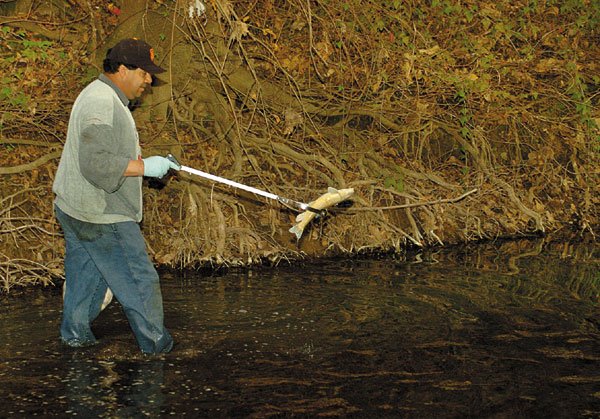Gilroy
– Three weeks after toxic levels of garlic-tainted wastewater
killed thousands of fish in Uvas Creek, water was again found
gushing into the waterway from a pipe owned by garlic producer
Christopher Ranch.
Gilroy – Three weeks after toxic levels of garlic-tainted wastewater killed thousands of fish in Uvas Creek, water was again found gushing into the waterway from a pipe owned by garlic producer Christopher Ranch.
A group of local environmental stewards and a federal fisheries regulator noticed the discharge at dusk Feb. 27, as they walked along the creek in the rain.
“It was coming out at a considerable rate and I would say at least a third of the pipe was exiting water,” said Jonathan Ambrose, a biologist with the National Marine Fisheries Service. “It was coming out at a rather considerable velocity.”
As a federal regulator in charge of administering the Endangered Species Act, Ambrose was examining the creek for issues that could affect steelhead trout. The fish is listed as a threatened species – one step shy of endangered – and Uvas Creek is one of its prime spawning areas. At least 10 steelhead are believed to be among the thousands of dead fish found along an eighth-of-a-mile stretch of the creek in early February – all casualties of a toxic stew of stormwater and rotting garlic. The creek meanders through the city before winding through the fields of garlic and other row crops at Christopher Ranch, just north of state Route 25.
After the wastewater was traced to an underground storage tank at the ranch, owner Bill Christopher immediately took steps to prevent another spill. The measures included cutting the line between an above-ground hand crank and the tank’s release valve more than six feet below ground, and locking the hand crank to prevent its use.
“If it was raining that heavy, I would expect that (the most recent discharge) was from the rainwater running off,” speculated Christopher, adding that he has not been contacted by authorities about the matter.
Ambrose said, however, that “the amount of water coming out of that pipe seemed far in excess of what you’d expect on a normal rainy day.”
For the moment, it is impossible for authorities to identify the source or type of discharge. Ambrose and two volunteers with nonprofit Coastal Habitat Education and Environmental Restoration, whose members discovered the original spill Feb. 3, did not collect water samples last Tuesday. By the time state fish and game warden Kyle Kroll learned of the spill the following afternoon, the pipe was dry.
“It’s under surveillance,” he said, but “no photos were taken and no enforcement personnel were there. At this time there is no hard evidence.”
Kroll expects to receive a toxicology report this week on the spill that occurred early February.
In the meantime, the latest discharge has raised eyebrows among district attorneys and water officials, who since the first spill have learned that the ranch was in violation of its wastewater permit and does not have a blueprint of the pipes running under its property.
“We are investigating this latest report of a discharge from Christopher Ranch with deep concern,” said Ken Rosenblatt, a Santa Clara County district attorney in the environmental protection unit.
Referring to the original spill, he added that “it appears clear that Christopher Ranch discharged wastewater into the creek, and there are both civil and criminal penalties.”
The law penalizes not only polluters who intentionally discharge, but those who cause environmental damage through negligence. A questioning of employees by Christopher did not root out the person who released the wastewater, but the ranch could still face penalties at the hands of state and federal officials. Federal law, for instance, allows fines of up to $12,500 for the death of every fish on the threatened species list, according to Ambrose.
The ranch is also receiving corrective orders from the Central Coast Regional Water Quality Control Board, the state group charged with monitoring the implementation of federal environmental regulations.
“I had thought that they had shut everything off and so there was no more risk of discharging wastewater into the creek,” said Mike Higgins, an engineer with the water control board. “I still don’t understand how water could have gotten into that pipeline.”
Higgins personally inspected the corrective measures taken by Christopher following the first spill. He speculated that the latest discharge could have resulted from other stormwater pipes that run into the culvert leading to the creek.
A wastewater permit issued to the ranch in 1991 prohibits the release of any discharge into the creek, Higgins said, as well as the mingling of stormwater with wastewater. Though both types of water pass through an underground storage vault, wastewater is typically piped to holding ponds for safe release into the ground. Higgins suspects that the first spill occurred because a pump failed in the underground vault and caused wastewater to overflow and mix with stormwater. That contaminated water filled up the vault and was eventually released by someone into the culvert leading to Uvas Creek, Higgins believes.
“I asked them who knows when the (underground wastewater vault) was installed and why it was installed that way,” Higgins said. “They said, ‘We don’t have anybody here who knows why that system is the way it is.’ They just had a 50th anniversary – a lot of folks who worked there in the past have moved on.”
He added that there is nothing wrong with releasing stormwater into a creek, as long as it never comes into contact with pollutants. To ensure against such mingling, the ranch must come up with a blueprint for their underground piping and install a back-up pump in the underground vault to prevent stormwater and wastewater from mixing.
Christopher said the ranch is working on mapping its pipes, though he could not say how long the process would take.
“We’re working with the regional water board,” he said, “and we’ll comply with whatever deadlines they set.”















